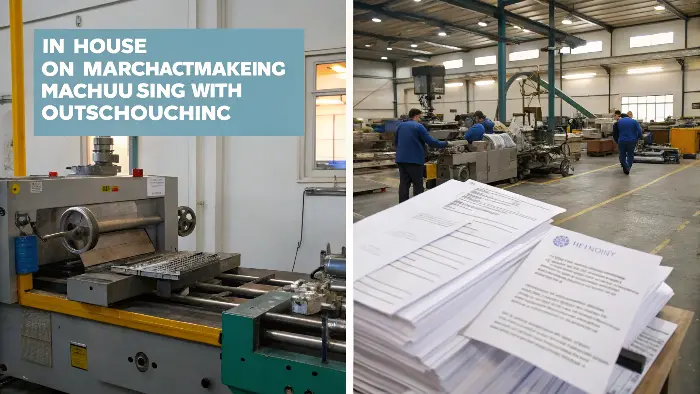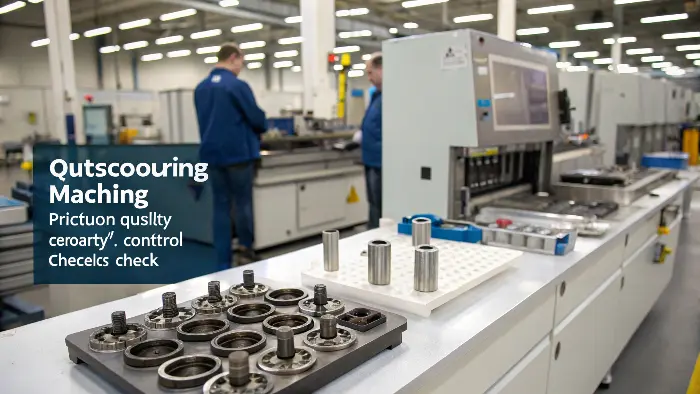Deciding whether to make your parts in-house or send them out is a big question for many businesses. The wrong choice can cost you time, money, and even affect your product quality. Getting this right is key to staying competitive and efficient.
The best choice between in-house and outsourced machining depends on your company’s specific needs. Factors like production volume, part complexity, available capital, technical expertise, and long-term strategic goals all play a crucial role in this important decision.

This is a dilemma I’ve seen many clients, including engineers like Alex, grapple with. There’s no single answer that fits everyone. Both paths have their pros and cons. As someone who started in a CNC shop and now helps companies source parts globally, I’ve seen both sides. Let’s break down the factors to help you think through what’s best for your situation.
What Are the True Costs of Setting Up In-House Machining?
Thinking about bringing all your machining under your own roof? It sounds like you’d have more control, but the initial excitement can fade when unexpected costs pop up. It’s really important to look at the complete financial picture before you jump in.
Setting up in-house machining goes far beyond just the price of a CNC machine. You must account for factory space, hiring and training skilled machinists and programmers, regular maintenance, cutting tools, CAM software, higher utility bills, and the ongoing costs of managing the operation.

I remember a company I consulted for a few years back. They were excited about buying their first 5-axis CNC machine. They budgeted for the machine itself, but the list of other expenses quickly grew. It’s easy to underestimate these.
Breaking Down In-House Costs
Let’s look at the different types of costs involved:
- Initial Capital Investment: This is the most obvious one. It includes the CNC machine(s), any necessary software (CAD/CAM), installation, and initial tooling packages. For high-precision machines, this can be a very significant outlay.
- Operational Costs: These are the day-to-day expenses. Think about skilled labor – CNC operators, programmers, maintenance staff. You’ll also have material costs (even for test runs and scrap), electricity, coolant, and replacement cutting tools, which wear out faster than you might think with certain materials.
- Hidden and Overhead Costs: This is where many companies get caught out. You need dedicated floor space, which has its own cost. Then there’s training for your staff, machine downtime (planned for maintenance or unplanned due to breakdowns), quality control equipment and personnel, insurance, and the management time needed to oversee the entire machining department.
A Closer Look at In-House Expenses
| Cost Category | Examples | Key Considerations |
|---|---|---|
| Capital Expenditure | CNC Machine, CAD/CAM Software, Fixturing | Machine capabilities, financing, depreciation |
| Facility Costs | Floor Space, Utilities (power, air), HVAC | Rent/mortgage, power requirements, environmental controls |
| Labor Costs | Machinists, Programmers, QC, Maintenance Tech | Salaries, benefits, training, skill availability |
| Consumables | Raw Materials, Cutting Tools, Coolant, Lubricants | Material type, tool life, disposal costs |
| Maintenance & Repair | Spare Parts, Service Contracts, Technician Time | Preventative vs. reactive maintenance, downtime impact |
| Quality Control | CMM, Gauges, Inspection Software, Personnel | Calibration, accuracy requirements, reporting |
| Overhead | Management, Insurance, Waste Disposal | Administrative burden, compliance |
While having machining in-house offers control over production schedules and potentially protects intellectual property more easily, it’s a big commitment. It makes sense if you have a consistently high volume of parts, relatively stable designs, and the financial resources to invest and manage it effectively. For many, especially startups or companies with fluctuating needs, these costs can be prohibitive.
What Advantages Does Outsourcing CNC Machining Offer?
Are you finding it hard to keep up with production demands, or do your parts need specialized machining that you don’t have in-house? Outsourcing might seem like you’re giving up some control, but it can actually open doors to greater expertise, flexibility, and even cost savings.
Outsourcing CNC machining provides access to advanced equipment and specialized skills without the heavy upfront investment. It allows for easy scaling of production, can reduce costs for lower volume or highly specialized parts, and frees up your team to focus on core business activities like design and innovation.

I work with many engineers like Alex who design amazing products but don’t have their own machine shops. For them, outsourcing is a lifeline. It allows them to tap into a global network of capabilities. At QuickCNCs, we act as that bridge, connecting them to reliable machining partners.
Key Benefits of Outsourcing
Let’s explore why outsourcing can be a smart move:
- Access to Specialized Expertise and Technology: Reputable machining suppliers often have a wide range of machines, including multi-axis CNCs, EDM, and specialized grinding equipment that might be too expensive for a single company to own. They also have experienced machinists who are experts with specific materials or complex geometries. I’ve seen suppliers who specialize only in titanium, for example.
- Cost Savings: This is a big one. You avoid the huge capital outlay for machines and infrastructure. Suppliers often achieve economies of scale by serving multiple customers, which can translate to lower per-part costs for you, especially for smaller batches or prototypes. You also convert fixed costs (like machine payments) into variable costs (paying only for parts you order).
- Scalability and Flexibility: Need to ramp up production quickly for a new product launch? Or perhaps you have a one-off project requiring a material you don’t normally work with. Outsourcing partners can often accommodate these fluctuations much more easily than an in-house shop with fixed capacity.
- Focus on Core Competencies: By outsourcing manufacturing, your team can concentrate on what they do best – perhaps it’s research and development, product design, marketing, or sales. This can lead to faster innovation and better market responsiveness.
Weighing the Pros and Cons
| Benefit of Outsourcing | Potential Concern/Mitigation |
|---|---|
| Lower Upfront Investment | Less direct control over production schedule (Mitigate with clear communication & reliable partners) |
| Access to Advanced Technology | IP protection concerns (Mitigate with NDAs & trusted suppliers) |
| Scalability (Up or Down) | Quality consistency across batches (Mitigate with strong QA processes & supplier audits) |
| Reduced Labor/Overhead Costs | Communication challenges (Mitigate with clear RFQs, regular updates, defined contact points) |
| Focus on Core Business | Longer lead times for shipping (Factor into planning, explore local vs. overseas options) |
Of course, outsourcing isn’t without its challenges. You need to find reliable partners, manage communication effectively (especially across time zones if sourcing globally), and ensure quality control. But with a good strategy and the right partners, these can be managed effectively. For many businesses, the flexibility and cost benefits make outsourcing a very attractive option.
How Do You Mitigate Risks When Outsourcing Machining?
The thought of sending your critical part designs to an outside company can be a bit scary. What if the quality isn’t right? What if they don’t understand your technical needs? These are perfectly normal worries, but you can take solid steps to build strong, reliable outsourcing partnerships.
To reduce risks when outsourcing machining, it’s vital to carefully check out potential suppliers. Look at their quality certifications (like ISO 9001 or AS9100 for aerospace), their technical abilities, how quickly and clearly they communicate, and always ask for references or even sample parts. Clear, detailed contracts are also a must.

This is something I emphasize constantly at QuickCNCs. Finding the right supplier is more important than finding the cheapest supplier. I’ve seen Alex, my engineer friend in Germany, become much more confident in outsourcing by developing a robust vetting process. It takes time upfront, but it saves a lot of headaches later.
Key Steps to Secure Outsourcing
Here’s how you can protect your projects and your business when outsourcing:
- Thorough Supplier Vetting: Don’t just look at a website. Dig deeper.
- Capabilities: Do they have the right machines, software, and experience for your specific type of parts and materials? Can they achieve the tolerances you need?
- Quality Systems: Are they certified (e.g., ISO 9001)? Ask about their quality control processes, inspection equipment, and how they handle non-conformances.
- References & Case Studies: Talk to their other customers if possible. Look at examples of similar work they’ve done.
- Site Visits (if feasible): If it’s a critical, long-term partnership, visiting their facility can be very insightful.
- Crystal Clear Communication: Ambiguity is your enemy.
- Detailed RFQs (Request for Quotation): Provide complete 2D drawings, 3D models, material specifications, required tolerances, surface finish, quantities, and desired delivery dates.
- Regular Updates: Establish clear communication channels and expectations for progress reports.
- Robust Quality Assurance: Don’t assume quality; plan for it.
- First Article Inspection Reports (FAIRs): Always request a FAIR for new parts to verify that the supplier can meet all specifications before starting full production.
- Material Certifications: Ensure they provide certs for all raw materials used.
- In-Process and Final Inspection: Understand their inspection methodology and reporting.
- Intellectual Property (IP) Protection: This is crucial.
- Non-Disclosure Agreements (NDAs): Have a solid NDA in place before sharing sensitive design information.
- Secure Data Transfer: Use secure methods for sharing files.
Checklist for Choosing a Machining Partner
| Area to Check | Key Questions to Ask | Red Flags |
|---|---|---|
| Technical Capability | What machines do you have? What are your typical tolerances? Experience with my materials? | Vague answers, outdated equipment, no experience with similar parts. |
| Quality Management | Are you ISO 9001 certified? Can I see your QC manual? How do you handle rejects? | No certifications, messy shop, poor documentation, defensive about QC. |
| Communication | Who is my main contact? How quickly do you respond? Can you provide progress updates? | Slow responses, language barriers (unmanaged), unclear answers. |
| Pricing & Lead Time | Is pricing transparent? Are lead times realistic and consistently met? | Unusually low prices (could mean quality cuts), consistently missed deadlines. |
| References | Can you provide references from similar customers? Can I see sample parts? | Reluctance to provide references, poor quality samples. |
Building a successful outsourcing relationship is a two-way street. Providing clear information and being a good customer helps your supplier do their best work for you. It’s an investment in a partnership that can significantly benefit your business.
Conclusion
Choosing between in-house and outsourced machining involves weighing costs, control, expertise, and flexibility. There’s no universal "right" answer. Carefully assess your specific business needs, production volumes, and strategic goals to make the most informed decision for your company’s success in precision manufacturing.


